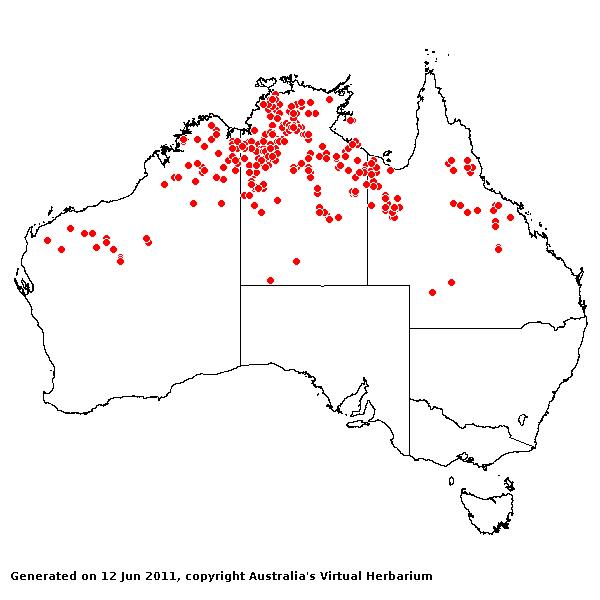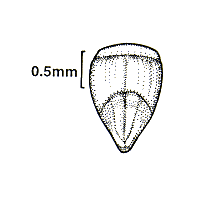Triodia bitextura M. Lazarides, nom
nov. Aust. Syst. Bot. 10: 412 (1997).
Classification.
(GPWG 2001) : Subfamily Chloridoideae. Triodeae.
Basionym and/or
Replacement Name: Triraphis
pungens R. Br., Prodr. 1: 185 (1810).
Type of Basionym or
Protologue Information: Queensland: Burke District; Islands of Gulf of
Carpentaria, R. Brown [6247] (HT: BM; IT: K, PERTH, E, B).
Recent synonyms: Plectrachne pungens, P. pungens var. callosum.
Key references
(books and floras): [1810]. R.Brown, Prodromus (185 as Triraphis
pungens), [1878] G.Bentham, Flora Australiensis 7 (604 as Triraphis
pungens), [1952] C.A.Gardner, Flora of Western Australia 1 Gramineae
(83 as Plectrachne pungens), [1981] M.Lazarides in J.Jessop (ed)., Flora
of Central Australia (446 as Plectrachne pungens var. pungens),
[2002] D.Sharp & B.K.Simon, AusGrass, Grasses of Australia.
Illustrations:
[1952] C.A.Gardner, Flora of Western Australia 1 Gramineae (84,
Pl. 23 as Plectrachne pungens), [2005] K.Mallet (ed.), Flora of
Australia 44B: Poaceae 3 (Fig. 35L-P).
Habit.
Perennial. Culms erect or geniculately ascending, 50–200 cm tall, 2–4 -noded.
Leaf-sheath auricles absent. Ligule a fringe of hairs. Leaf-blades curled or
flexuous, conduplicate or involute, 10–45 cm long, 0.5–0.7 mm wide.
Inflorescence.
Inflorescence compound, a panicle or a panicle. Panicle lanceolate or oblong,
10–30 cm long.
Spikelets.
Spikelets pedicelled. Fertile spikelets many flowered, with at least 2 fertile
florets (2–6), comprising 2–6 fertile floret(s), with diminished florets at the
apex, elliptic, laterally compressed or terete, 8–20 mm long.
Glumes.
Glumes similar, thinner than fertile lemma. Lower glume lanceolate, membranous
or scarious, without keels, 3 -nerved. Lower glume surface glabrous. Lower
glume apex mucronate or awned. Upper glume lanceolate, 7–15 mm long, membranous
or scarious, without keels, 3 -nerved. Upper glume surface glabrous. Upper
glume apex entire or lobed, mucronate or awned.
Florets.
Fertile lemma 7–10 mm long, without keel, 3–9 -nerved. Lemma surface
indumented. Lemma apex lobed, awned, 1–3 -awned. Median (principal) awn 7–15 mm
long overall. Lateral lemma awns present. Palea 2 -nerved. Palea apex dentate.
Anthers 3.
Continental
Distribution: Australasia.
Australian
Distribution: Western Australia, Northern Territory, Queensland.
Western Australia:
Gardner, Fitzgerald, Hall, Dampier. Keartland, Fortescue, Ashburton. Northern
Territory: Darwin & Gulf, Victoria River, Barkly Tableland. Queensland:
Burke, Cook, Gregory South, North Kennedy, South Kennedy, Mitchell.
Notes.
Distinguishing characters include the bitextured lemma and palea; appressed
lemma pubescence; few-nerved glumes subequal to body of the spikelet; markedly
unequal awns; short keels relative to the palea. Similar to P. schinzii
in spikelet morphology, but dissimilar in its smaller spikelet, fewer-nerved,
shorter glumes relative to the spikelet, shorter blunter callus, often hairy
palea and curled-flexuose blades. Often the hyaline part of the palea is longer
relative to the lower indurated part.
On
the mainland and coastal islands N of lat. 23°S in W.A., on the mainland and
coastal islands N of lat. 21°S in the N.T., and in the Burke, Mitchell, Gregory
S and S Kennedy Districts of Qld. In deep sandy soils or silty sands on plains
and dunes, and in shallow or skeletal, often stony or gravelly soils on
hillslopes, scree slopes, tablelands, outcrops, ridges, mesas, ranges, and
plateaux of sandstone, quartzite, laterite, and calcareous or volcanic rocks;
also in or near watercourses and floodplains; occasionally on heavy clay, clay
soils, and in saline depressions and saline sand over alkaline clay in
interdune corridors; flowers mainly Oct.-Feb., but persisting in all seasons;
fruits mainly Oct.-Feb., but persisting in all seasons.




